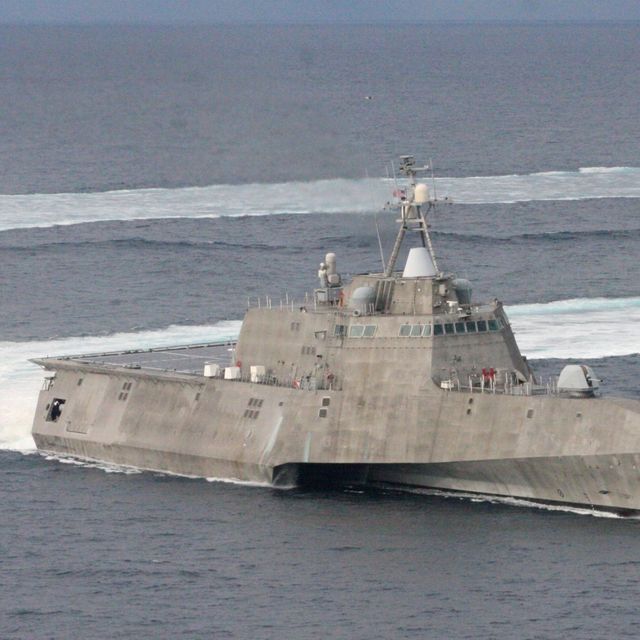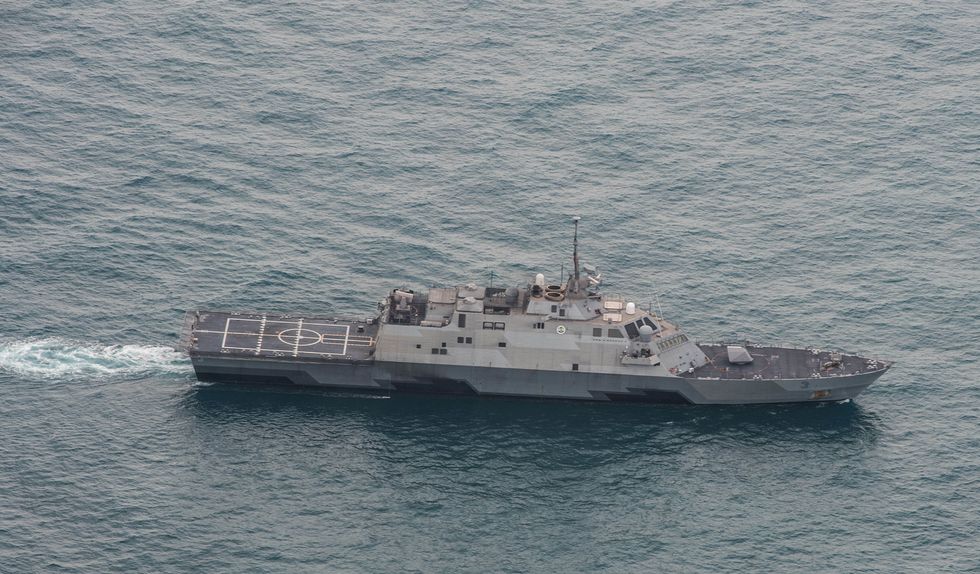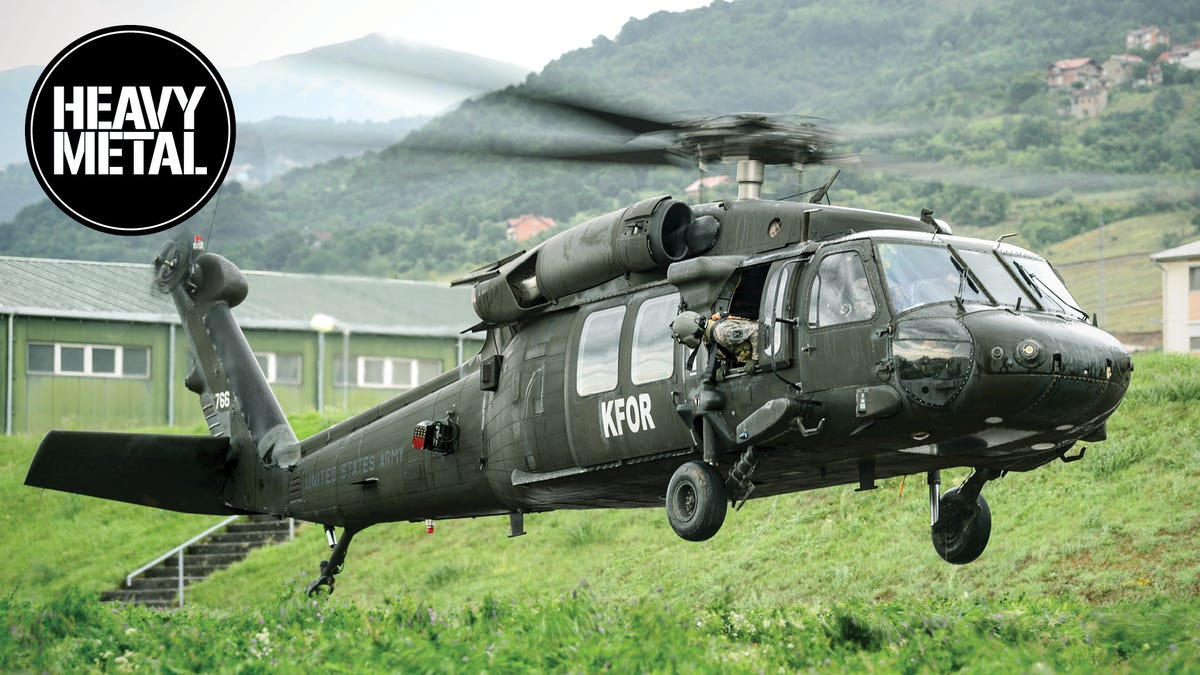- Last month, the Navy decommissioned the littoral combat ship USS Independence.
- Designed for the post-9/11 world, the ship served for less than half of its anticipated lifetime.
- The service is decommissioning the four oldest littoral combat ships, citing high costs for upgrades.
The U.S. Navy decommissioned the littoral combat ship (LCS) USS Independence last week after just 11 years in service. The ship—the first of a new class of warships designed to fight in the era of post-9/11 conflicts—served for less than half of its expected lifespan. Altogether, the service is removing the first four LCS ships from service, citing high upgrade costs.
On July 29, the Navy removed Independence from the fleet during a ceremony at Naval Base San Diego. The event was closed to the public for health and safety reasons related to the ongoing COVID-19 pandemic. Next, the service will mothball Independence and assign it to the reserve fleet.
A tugboat will take Independence to Bremerton, Washington, one of two reserve fleet locations on the West Coast. There, she will await recall orders in the event of emergency. If not recalled, the service will eventually scrap the ship.
USS Independence was commissioned into the Navy in January 2010. The ship was the second littoral combat ship to enter service, and the second that shipbuilder Austal USA completed. Independence is one of four early production littoral combat ships that the Navy wants to retire, because it would cost too much to upgrade them to serve out their anticipated 25-year service lives.
The LCS class is unique in that it consists of two ship types: an Austal-built trimaran hull, and a Lockheed Martin-built traditional monohull. Those companies designed the LCS ships to operate in both shallow and coastal waters, allowing them to sweep sea mines, hunt enemy submarines, and attack other ships and land targets. The small, scrappy ships could use swappable "mission modules" to help them quickly change their mission with a crane and a short stay at port. The ships could accomplish all of this with smaller crews, reducing manpower costs.
Because the U.S. Navy wanted to remain relevant in the post-9/11 era—a period dominated by land wars in countries like Iraq, Afghanistan, Somalia, and Libya—the LCS class was born. The Navy pitched LCS as a ship that could operate off the coastlines (if any) of war-torn countries and support the fight on land however possible. Concepts such as mission modules and minimal manning were meant to demonstrate affordability, with the service doing more work, while requiring fewer sailors and ships.
Originally, the Navy planned to build scores of the inexpensive ships, basing them near conflict zones where they could use their high speed to quickly respond to threats. But unfortunately, the LCS program failed.
The ships, although fairly inexpensive, were only lightly armed and relied on mission modules that spent more than a decade in development; the anti-submarine and minesweeping modules are only now entering service. As a result, many ships in the LCS fleet have spent a half-decade or more armed with nothing more than Mk-110 57-millimeter rapid-fire guns, 30-millimeter cannons, and close-in weapons for defense.
The program suffered from other problems, too. The Navy envisioned LCS ships as lightly manned in hopes of saving money on personnel costs, but the relatively few sailors serving aboard them became overburdened with work. The ships were designed for speed, with both types capable of sprinting at more than 40 knots. However, it soon became clear that it would have been far better to prioritize a longer range instead. At the same time, mechanical problems plagued the LCS ships, and overseas bases (near crisis zones like the South China Sea) never actually materialized.
It gets even worse. A single LCS ship costs between $50 million and $70 million a year, depending on who you ask. That's a lot of money for a small ship with a small crew and not much capability. By comparison, an Arleigh Burke-class guided-missile destroyer (a much larger and more capable warship) costs $80 million a year to operate.
Two of the Freedom-class ships, Detroit and Little Rock, suffered combined gear damage so extensive that the Navy would rather retire them than fix them—making the actual number of LCS ships on the chopping block a total of six. USS Detroit, for her part, was commissioned into the Navy in 2016, making her just five years old. Lockheed Martin is trying to come up with a fix for the problem, which affects all of the Freedom-class ships.
LCS ran into another buzzsaw: the rise of China's People's Liberation Army (PLA) Navy. Since 2010, China built 30 Type-054A frigates and 72 smaller, but still roughly LCS-sized, Type-056 corvettes. Compare that to the Navy's 23 LCS ships. That suddenly left LCS, originally designed to hunt mines and send commandos ashore, with competitors that heavily outgunned it. China's 102 frigates and corvettes were delivered from the shipyard fully armed, including anti-ship missiles. Only a handful of the LCS ships are armed with anti-ship missiles, though that number is set to rise to 31 ships equipped by late 2022/early 2023.
Here's a video of the littoral combat ship USS Gabrielle Giffords launching a Naval Strike Missile during exercise Pacific Griffin:
The Pentagon responded—belatedly—to the LCS mess by cutting the number of ships it will buy from 55 to just 35. Retiring six ships early will cut that number again to 29, or a little more than half the force originally promised. The service will instead buy 20 Constellation-class guided-missile frigates. The Constellation-class frigates are larger and more expensive, but are also much more capable than comparable PLA Navy ships.
Independence, as the first ship of her kind, was very much a prototype, and part of a work-in-progress. But nobody ever said the ship would last just 11 years in service, nor did anyone say that six of the ships would be retired before shipbuilders had even lowered the last one into the water. Turns out, the rest of the LCS program, more than a decade after it started, is still an expensive work in progress.
🎥Now Watch This:

Kyle Mizokami is a writer on defense and security issues and has been at Popular Mechanics since 2015. If it involves explosions or projectiles, he's generally in favor of it. Kyle’s articles have appeared at The Daily Beast, U.S. Naval Institute News, The Diplomat, Foreign Policy, Combat Aircraft Monthly, VICE News, and others. He lives in San Francisco.















